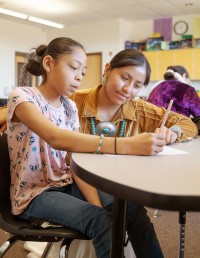Educational Rights of Children in Foster Care Are Written into Law with A.B. 490
In 2003, with the enactment of Assembly Bill 490, California became the first state in the nation to create a comprehensive set of laws designed to improve educational outcomes for children in foster care. NCYL has played an ongoing role in the drafting and implementation of these laws.
The challenges to school success for youth in foster care are numerous and well-documented. Frequent placement changes, lost or delayed school records, and the emotional upheaval of starting over in a new school are just a few of the challenges facing foster youth. Educational experts estimate that, on average, each school change results in four to six months of lost education time. One study showed that foster youth in California attend an average of nine different schools by age 18. Another California study showed that school changes during the high school years had a profoundly detrimental impact on a student’s chances of graduating. Before the passage of AB 490, foster youth moving schools might find themselves enrolled in classes they had already taken, attending a school that wasn’t aware they were supposed to receive special education services, or even stuck in limbo for weeks at a time, unable to start their new school until the agencies located and transferred the student’s immunization records.
On February 14, 2003, then-Assemblymember Darrell Steinberg introduced AB 490, co-sponsored by California Youth Connection, the Children’s Law Center of Los Angeles, and the Children’s Advocacy Institute. The bill passed the legislature by wide margins. It was enacted October 12, 2003, and went into effect January 1, 2004.
Among its key provisions, AB 490 gave foster youth important rights related to their education. Foster youth now had the right to remain in their “school of origin” for the remainder of the school year, even if their foster care placement changed. Foster youth were now entitled to placement in the “least restrictive” school setting, with equal access to academic resources, services, and extracurricular activities. School districts were now required to give foster youth credit for full or partial coursework done at prior schools. School districts could no longer deduct credits or lower a student’s grade for missing school due to court appearances or placement changes. AB 490 made the school district and the county social services agency jointly responsible for transferring a foster student’s educational records, with strict time limits in place. And regardless of whether all the records had transferred, schools were now required to immediately enroll incoming foster youth. Each school district would also appoint a foster youth liaison to oversee enrollment and to ensure the smooth transfer of credits and records.
After AB 490’s passage, NCYL played a leading role in the law’s implementation, conducting trainings, representing individual students, advocating for further needed legislation, serving on the statewide California Foster Youth Education Task Force, and even going to court to enforce AB 490 so that the promise of educational stability for children in foster care could be fulfilled.
In 2008, NCYL learned that a high school student in foster care was being threatened with disqualification from football based on a paperwork technicality after he moved to a new school due to a change in placement. NCYL won an emergency order in Superior Court halting the football playoffs and finding that the by-laws of the state agency overseeing interscholastic sports violated AB 490 and unconstitutionally discriminated against foster youth. The case, Dyer v. California Interscholastic Federation, led to a change in the agency’s by-laws as well as to state legislation to clarify that foster youth changing schools are immediately eligible for extracurricular activities, including sports.





